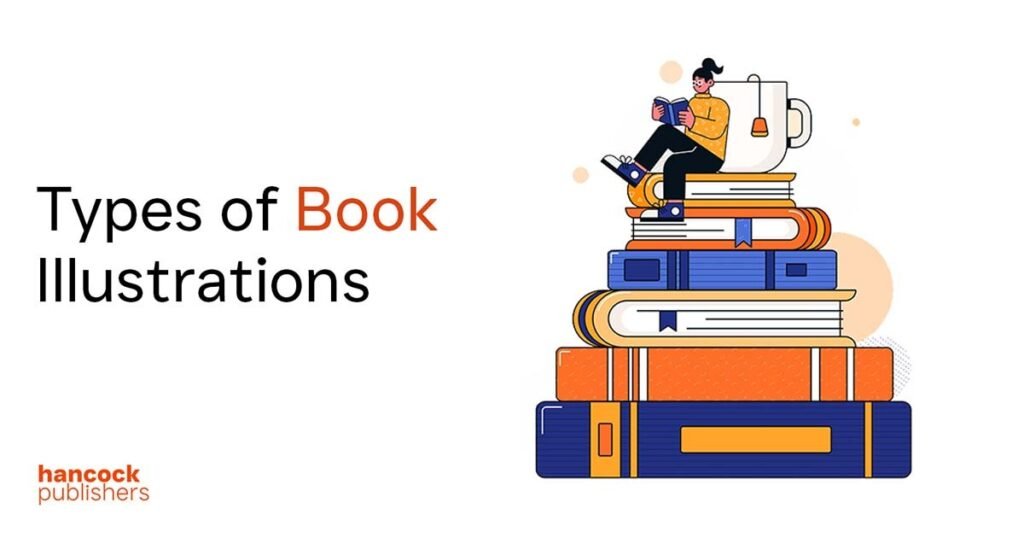Types of Book Illustrations

Illustrations are vital tools in visual communication. They help explain concepts or ideas through images. Illustrations have evolved from ancient times, when drawings on walls conveyed stories or information, to the present day when digital technology enables artists to create detailed and varied visuals.
Now, visuals are not just for decoration. They help brands stand out, enrich stories in books and comics, add depth to video games, and assist in fashion design. Different types of illustrations, such as pencil sketches, watercolors, or digital art, fit specific purposes and styles.
Illustrations work well because our brains can understand them faster than reading words. This makes them a great way to share ideas or messages. Thus, illustrations stay valuable and popular in traditional and modern information-sharing methods.
Illustrations continue to be vital to generating stories and creating businesses. Let’s read about the types of illustrations in detail to ensure you survive in a world where visual content is paramount.
The Purpose Of Illustrations in Books
Illustrations bring stories and concepts to life, bridging the reader’s imagination and the author’s words. They range from simple sketches to detailed art, which play a crucial role in storytelling, particularly in books.
Illustrations in books make the reading more interesting. They add visuals and excitement to the pages and help readers engage with the story. This way, visual cues make understanding the plot and characters easier.
But the power of illustrations isn’t limited to basic literature. They enrich all types of books, including other diverse genres. Illustrations can simplify complex ideas in non-fiction and educational materials, making them easier to grasp. Diagrams, charts, and maps are common types of illustrations that serve this purpose, offering visual explanations that complement the text.
In fiction, illustrations can set the tone and atmosphere of the story, giving readers a glimpse into the setting and characters imagined by the author. So, book illustrations can transform a simple reading experience into a more intense journey.
Although people often confuse illustrations with graphic design, they each have their own unique qualities and purposes.
To clear up any confusion, let’s take a closer look at what sets them apart.
Illustrations Vs. Graphic Designing
While both illustrations and graphic design are important for visual storytelling and communication, they serve different roles and have multiple uses.
Illustrations provide visuals that improve and complement the written material, especially for print media like books, periodicals, and websites. They beautifully represent situations, people, or settings in literature, enhancing the reading experience with depth and feeling.
Children’s books, where the visuals not only tell the story but also captivate young readers and foster their imaginations, also heavily depend on their illustrations. They can simplify difficult ideas in instructional materials, increasing accessibility and enjoyment of learning.
However, Graphic Design has more types of uses and is centered on employing type, space, color, and images to solve problems and communicate ideas visually. Web design, user interfaces, marketing, and brand identities (logos and branding materials) all depend on graphic design.
It bridges the gap between art and technology to convey ideas, aiding in product promotion and sales as well as improving the usability and appeal of websites and applications.
It is best to utilize Illustrations in the following:
- Children’s books use illustrations to tell stories.
- Books, both fiction and non-fiction, include illustrations that enhance the narrative.
- Educational resources to facilitate comprehension by presenting data in a visual manner.
- Editorial content provides an additional level of interaction by illuminating news items, blogs, and tales.
Where Graphic Design Fits in:
- Branding when it comes to the development of logos and brand identities that capture a company’s soul.
- Advertising is the process of creating eye-catching campaigns that draw in and influence potential clients.
- Creating aesthetically pleasing and user-friendly interfaces for digital products is known as web and app design.
- Producing flyers, brochures, and digital content to advertise goods and services is known as marketing materials.
Planning to Create a Fascinating Book Cover Design?
Specialized Forms of Book Illustrations
Visual Storytelling
Illustrations are powerful storytelling tools. They convey emotions, settings, and character details that words do not capture.
In children’s books, illustrations often play a primary role in storytelling. They allow young readers to follow the narrative even before they can read the text.
Enhancing Comprehension
Illustrations can make complex information or abstract concepts more accessible. Educational content and other visual aids help readers grasp difficult subjects. Scientific theories and mathematical principles can be defined. Visual representations can simplify information, making learning more engaging and effective.
Attracting Attention
A book’s cover illustration is crucial in attracting potential readers. It is a visual summary of the book’s content or theme, appealing to the reader’s curiosity and emotions.
Illustrations help break up the text in the book, facilitating better understanding. They also make the layout more inviting and easier to navigate.
Setting Tone and Atmosphere
Illustrations contribute to a book’s mood. The choice of colors, style, and subject matter can evoke specific emotions. This process sets the tone for the story or chapter.
For instance, dark, shadowy illustrations might create a sense of mystery or foreboding. Meanwhile, bright and colorful images can convey happiness and excitement.
Cultural and Historical Context
Illustrations can provide readers with visual context. They help them understand the cultural or historical setting of a story. This is important in historical fiction, biographies, and books that explore diverse cultures.
Illustrations bring the clothing, buildings, and daily activities from various times and places. to life This enriches our understanding and draws us deeper into the story.
Encouraging Engagement and Imagination
Illustrations draw readers in. They make them feel a part of the story’s world and spark their imaginations. This is helpful as it allows them to engage more with the text.
This engagement is not only entertaining but also stimulates creativity and critical thinking. Illustrations can be a gateway to a lifelong love of reading and storytelling.
Supporting Branding and Marketing
In the competitive world of publishing, illustrations can help a book stand out. Unique and appealing illustrations can become associated with a book. They can also become the face of a particular series or author, becoming part of the brand identity.
This visual branding is crucial for marketing. It makes books more recognizable and memorable to readers.
Traditional Book Illustration Techniques
Woodcut
Woodcut is one of the earliest methods of printing illustrations in books. It involves carving an image into the surface of a wood block. When inked and pressed onto paper, it creates a print.
In the 15th and 16th centuries, people used woodcut methods to illustrate books. This method was used primarily for religious texts and chapbooks. Woodcuts are recognizable because of their stark contrast and bold lines.
Engraving and Etching
Engraving is the process of using a burin to carve or cut a design into a metal plate. In contrast, etching involves drawing on the metal with a needle and then using acid to eat away at the areas exposed by the needle’s marks.
These techniques help create finer details. From the 16th to the 19th centuries, they were popular in illustrating scientific and medical books.
Lithography
Lithography is a printing process based on the repulsion of oil and water. It was invented in the late 18th Century. The method was traditional, as the artist drew on a limestone or metal plate with a greasy substance. The surface was then treated so the ink adhered only to the drawn areas.
Lithography made it possible to produce illustrations that closely resembled the original drawings. It enabled the broader dissemination of artistic and pictorial books.
Watercolor Illustrations
Before the advent of color printing, illustrations were often hand-colored with watercolor. This medium was favored due to its transparency and range of hues.
Watercolor illustrations are characterized by their soft, fluid appearance. They were commonly used in children’s books, botanical illustrations, and fine art books.
Modern Illustration Techniques
Halftone Printing
The invention of halftone printing in the late 19th century revolutionized book illustration. They helped produce photographs and paintings with gradations of tone.
This process converts images into a series of dots of varying sizes. It was used to simulate shades of gray or color, making it a staple for newspapers, magazines, and books.
Digital Illustrations
The digital era has introduced various new techniques for creating book illustrations. Artists can produce images that range from hyper-realistic to stylized. They use software like Adobe Photoshop and Illustrator.
Digital illustration allows unparalleled versatility and efficiency. It facilitates the creation of e-books. Yet, it also enhances the visual appeal of all genres of digital and printed books.
Conclusion
Book illustrations are a vital element in the publishing world. They offer more than visual enrichment. They act as a link between what the author writes and what the reader imagines. They help boost understanding, involvement, and pleasure between the reader and the writer.
As technology and art styles evolve, so will book illustrations. This keeps illustrations a vital and vibrant part of storytelling.
Book illustrations bring the touchable charm of print to the endless world of digital art. They continue to enchant and inspire readers everywhere, no matter their age.
Subscribe to our Newsletter
Ready to turn your manuscript into an eBook?
Turn your ideas into a best-seller with Hancock Publishers!





